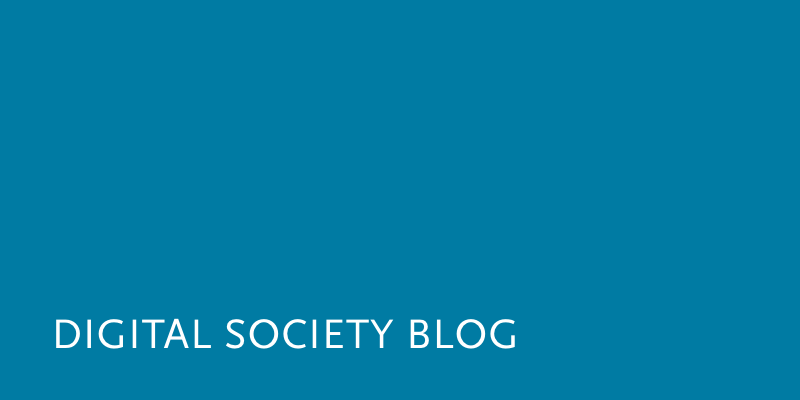Making sense of our connected world

Who benefits from the so-called New Media Revolution?
The new media revolution is a common metaphor that is often used to describe the contemporary communications ecosystem. This essay investigates how it influences the way individuals, groups and policy makers interpret their mediated reality. Researchers Noam Tirosh and Amit Schejter claim that while Google, Facebook and other conglomerates describe the contemporary media ecosystem as free and revolutionary in essence, they are seeking to increase their control over this ecosystem. We contend that the new media revolution will only begin when we enable access to media for disconnected individuals and communities, and make sure that they can capitalise on this media.
Noam Tirosh, Ben-Gurion University of the Negev / Northwestern University
Amit Schejter, Ben Gurion University of the Negev / Penn State University
Dossier: How metaphors shape the digital society
Obviously, each new appearance among men stands in need of a new word, whether a new word is coined to cover the experience or an old word is used and given an entirely new meaning. (Hannah Arendt, On Revolution, 1963, p. 25-26)
The new media revolution is a common metaphor often used to describe the contemporary communication ecosystem. Indeed, metaphors, images, similes and imaginaries are crucial to the way we understand the world we live in. Individual and collective imagination, metaphors and other linguistic devices act as discursive building blocks when members within a society interpret and cope with the reality surrounding them. New phenomena, in Arendt’s (1963) words, are in need “of a new word”.
These discursive constructions may also influence the process of designing information policy. The history of media regulation is replete with images such as the marketplace of ideas, the information superhighway, the digital divide and cyberspace. Descriptions, comparisons and representations serve to simplify an explanation and to illustrate what words sometimes cannot. At the same time, they are often used in order to obscure the ideological tenets that are at play when shaping and extracting policies. In this short essay, we focus on the new media revolution metaphor and how it influences the way individuals, groups and policy makers interpret the mediated reality they operate in.
Using the metaphor
Among the people most busy advancing the revolution discourse are Mark Zuckerberg of Facebook, Larry Page and Sergey Brin of Google/Alphabet. They are seeking to shape the way people experience the world and the role of media technology in it. “There have been moments in history where the invention of new technology has completely rewired the way our society lives and works,” wrote Zuckerberg in The Wall Street Journal in 2014. “In the coming decades,” he continued, “we will see the greatest revolution yet, as billions of people connect to the Internet for the first time.” Zuckerberg has also used the term revolution in other contexts. He talked about how India “embraced the computer revolution,” mentioning that India has “a vibrant computer industry and a lot of the best engineers in the world”. In 2016, he stated that there is “a big revolution that is happening.” This revolution, he continued, gives:
Teachers and students need the tools to learn […] the content that they care about [at]the pace that fits them […], learning in a way that fits them, you know, whether that’s, uh, watching a video or playing a game or reading or working with other students or tutoring,[…], giving people the tools that they need there. (Zuckerberg, 2016)
Sergey Brin, for his part, has recently noted that “[t]he revolution in deep nets has been very profound, it definitely surprised me, even though I was sitting right there.” He has also commented that “the openness of the web which has fuelled the information revolution is vanishing because of censuring by countries such as China and companies creating monopolies.” His partner at Google Larry Page has claimed that “change tends to be revolutionary, not evolutionary” and that “especially in technology, we need revolutionary change, not incremental change.”
Drawing on the revolution metaphor, Google is seeking to counter any attempt to regulate the internet. They are focused on regulations that limit, in their opinion, the perceived new media revolutionary attributes. Thus, for example, in a 2014 submission to an Israeli committee contemplating the future of and need for regulating audio-visual services provided via the Internet (Prof. Schejter and Dr. Tirosh served as the Committee chair and his aid respectively.), Google wrote (in Hebrew) that the Internet “encourages pluralism and provides opportunities for realizing freedom of expression”. According to the submission, the internet facilitates freedom of expression in its widest sense, due to the lack of entry barriers and space or time burdens (Ibid). The internet revolution they describe identifies only one barrier that needs to be removed – direct speech regulation.
On revolution
What happens here is that an old word, revolution, is being used to describe new phenomena, thus granting the word “an entirely new meaning” (Arendt 1963: 25-26). Yet, it is important to get back to the conventional meaning of the term revolution. Revolution is most commonly defined as the “forcible overthrow of a government through mass mobilization (whether military or civilian or both) in the name of social justice, to create new political institutions“ (Goldstone 2014: p.4).
Some prominent thinkers, however, suggest that revolutions are not about “mere changes” (Arendt, 1963, p.11). In The Structure of Scientific Revolutions, Thomas Kuhn (1962/1970: 5) defines revolution as the instance in which the new discovery “necessitated the community’s rejection of one time-honored scientific theory”. A scientific revolution, he explains, produced a consequent shift in the problems available for scientific scrutiny and in the standards by which the profession determined what should count as an admissible problem or as a legitimate problem-solution. And each transformed the scientific imagination in ways that we shall ultimately need to describe as a transformation of the world within which scientific work was done. Such changes, together with the controversies that almost always accompany them, are the defining characteristics of scientific revolutions (p. 6).
At the same time, Arendt claimed that the term revolution should refer to social incidents that focus solely on the “foundation of freedom” (Arendt 1963: 51). For Arendt, the tension between freedom and tyranny is constitutive for the very existence of politics. Thus, for her, the only way to understand revolutions is to acknowledge that “the idea of freedom and the experience of a new beginning should coincide” (Arendt 1963: 19).
Indeed, for both Kuhn and Arendt, revolutions are not mere changes in a perceived reality; instead, they are an inherent alteration of the foundation of reality. Revolutions are, on the one hand, a rejection of the way things are, and on the other hand, a moment of liberation from oppression. Thus, the replacement of one form of oppression with another is not a revolution in Arendt’s or Kuhn’s understanding.
What do Google and Facebook mean when they speak about the new media revolution?
Google, Facebook and the like claim that the contemporary media environment should stay out of the regulatory bodies’ scope, due to the revolutionary attributes of this environment. However, they are in fact trying to increase their own control over the contemporary media environments, while describing these environments as free and revolutionary in essence. Revolution, in that sense, is used neither in the Arendtian or Kuhnian manner. The so-called revolution Google wants is one that will free them from having to adhere to laws and regulations. Google, Facebook and other media conglomerates are actually aiming to minimise the freedom and liberties of individual users through their active denial of any regulations that may benefit users and increase their freedoms when using contemporary media.
And indeed, more freedom and liberty is possible. It is the unique characteristics of contemporary media – mobility, interactivity, abundance and multimediality – that enable a new regulatory discussion. The new affordances enabled by these media have the potential to drive justice-based communication policies and to improve the situation of the least advantaged among civilians (Schejter & Tirosh, 2016). Only by enabling access to media for disconnected individuals and communities, and by making sure that they can capitalize on these media, we believe that freedom would be increased, and the new media revolution will truly begin. Unfortunately, the current discourse rather hides than reveals this potential. That is why we need to be cognizant of the double-edged use of the term revolution: to ensure it serves the people, and not the new rulers.
References:
| Arendt, H. (1963[2006]). On Revolution. London: Penguin Books.
| Goldstone, A. J. (2014). Revolutions – A Very Short Introduction. New York: Oxford University Press.
| Internet.org, “Internet org summit in New Delhi” (2014). Zuckerberg Transcripts. Paper 158. http://dc.uwm.edu/zuckerberg_ les_transcripts/158.
| Kuhn, S. T. (1970), The Structure of Scientific Revolutions (2nd ed.). Chicago: University of Chicago Press.
| Meyrowitz, J. (1993). Images of Media: Hidden Ferment – and Harmony – in the Field. Journal of Communication, 43(3), 55-66.
| Schejter, A. & Tirosh, N. (2016) A Justice-Based Approach for New Media Policy: In the Paths of Righteousness. London: Palgrave-McMillan.
| Zuckerberg, Mark, “Live discussing the election, news, education, science, AI and the future at Techonomy” (2016). Zuckerberg Transcripts. Paper 214. http://dc.uwm.edu/zuckerberg_ les_transcripts/214
| Noam Tirosh, PhD, is a lecturer in the Department of Communication Studies at Ben-Gurion University of the Negev. He is currently a visiting scholar at the Crown Family Center for Israel and Jewish Studies, Northwestern University. Amit Schejter, PhD, is Professor and Head of the Department of Communication Studies at Ben Gurion University of the Negev, and Visiting Professor and co-Director of the Institute for Information Policy at the Donald P. Belisario College of Communications, Penn State University. |
| If you are interested in submitting a piece yourself, send us an email with your suggestions. |
This post represents the view of the author and does not necessarily represent the view of the institute itself. For more information about the topics of these articles and associated research projects, please contact info@hiig.de.

You will receive our latest blog articles once a month in a newsletter.
Platform governance
AI at the microphone: The voice of the future?
From synthesising voices and generating entire episodes, AI is transforming digital audio. Explore the opportunities and challenges of AI at the microphone.
Do Community Notes have a party preference?
This article explores whether Community Notes effectively combat disinformation or mirror political biases, analysing distribution and rating patterns.
How People Analytics can affect the perception of fairness in the workplace
People Analytics in the workplace can improve decisions but may also heighten feelings of unfairness, impacting employee trust and workplace relationships.



